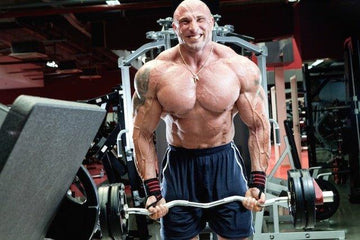

How the Muscle Pump Creates Muscle Growth
Table of Contents
How the Muscle Pump Creates Muscle Growth
by: Robbie Durand
If there is one thing that lifters can’t do day in and day out is continually train heavy. All lifters need periods of rest and recuperation with reduced weight. The famous Greek strongman Milo of Croton reportedly gained massive strength by adding a little bit of weight every day. He was said to have achieved the feat of lifting the bull by starting in childhood, lifting and carrying a newborn calf and repeating the feat daily as it grew to maturity. It would be equivalent to squatting every day and adding a 2 and a half pound plate to the bar every day. It’s clear that in theory that this type of training sounds legit, but this would lead to massive overtraining. Powerlifters and Olympic lifters certainly don’t life this way, as we know that serious strength athletes use various forms of periodization with periods of heavy and light training.
Reports indicate that muscle protein synthesis at rest and in recovery from resistance-type exercise reaches maximal stimulation after consuming a 20 gram serving of high-quality protein such as whey protein. Under those conditions, intracellular amino acid transport appears saturated in muscle, and no further increases in protein synthesis occur. Basically, the muscle is saying, “I am full, not need for any more amino acids!” Taking BCAA’s are not just good for increasing protein synthesis but they also kick start the muscle recuperation process. In fact, a study, published in the Journal of the International Society of Sports Nutrition, investigated how BCAAs impact the recovery process. Researchers found that BCAA supplementation taken before and after “damaging” resistance training reduces signs of muscle damage and accelerates recovery in resistance-trained males.
 The good news is that in the latest issue of Clinical Nutrition reported that lightweight and amino acids can stimulate big increases in protein synthesis. Hyperaminoacidemia (i.e. large increases in amino acids) stimulates muscle protein synthesis in resting skeletal muscle. Researchers wanted to investigate whether light-load resistance exercise in conjunction with amino acids can enhance muscle protein synthesis.
The good news is that in the latest issue of Clinical Nutrition reported that lightweight and amino acids can stimulate big increases in protein synthesis. Hyperaminoacidemia (i.e. large increases in amino acids) stimulates muscle protein synthesis in resting skeletal muscle. Researchers wanted to investigate whether light-load resistance exercise in conjunction with amino acids can enhance muscle protein synthesis.
Ten healthy males exercised one leg with a light-load resistance-like exercise at 16% of 1 repetition maximum and received small protein doses over the day. This is an extremely lite weight and the lifters just pumped up the muscle. Muscle biopsies were obtained from the resting and exercised muscles every 2.5-hours in the protein-fed period. At the end of the study, protein feeding significantly elevated plasma leucine (~39 %) and essential amino acids (~20%) compared to the basal concentrations at rest. Compared to rest, light-load exercise prolonged the stimulatory effect of dietary protein on muscle synthesis. This means maximal protein synthesis can be stimulated with a very light weight. This is not the first study to show that using lighter weight can increase muscle protein synthesis. This means that as long as you are consuming a amino acid or protein supplement, you can have a high rep training session and get equal increases in protein synthesis throughout the day.
 Training to Failure and Whey Enhances Muscle Protein Synthesis
Training to Failure and Whey Enhances Muscle Protein Synthesis
If your are going to be using a lite weight and repping it out in the gym, make sure to train to absolute failure. Researchers reported that taking sets to failure seemed to enhance the anabolic effects of whey protein regardless of how much weight was lifted. The researchers had subjects consume a whey protein drink (15 grams of whey protein) at rest and before exercise and then had the subjects perform leg exercises where immediately after they had muscle biopsies taken to measure markers of protein synthesis. The subjects performed either:
1.) four sets at 90% of maximal strength to failure;
2) 30% work-matched not to failure; or
3) 30% to failure.
So in sum, the researchers had the subjects lift heavier weights to failure (90% of a 1-RM) and lighter weights to failure (30% of a 1-RM), and lightweights not until failure (30% of a 1-RM). At the end of the study, protein synthesis was increased after exercise for 24 hours after exercise was performed. Additionally, the researchers reported that regardless of intensity or weight used, the researchers found that muscle protein synthesis was observed only after exercise performed until failure (i.e. 90% until failure and 30% until failure), which may suggest that maximal fiber activation (especially of type II fibers) is necessary for activation of muscle protein synthesis after exercise.
When exercise in the liteweight group was not taken to failure, protein synthesis did not occur. The researchers speculated that protocols eliciting maximal fiber recruitment (i.e. both type I and type II fibers using manipulations of load and volume to induce fatigue) during exercise are critical to enhancing the anabolic effects of exercise for at least 24 h postexercise recovery. One may question how can a weightlifting programs using such a lightweight be useful for enhancing muscle protein synthesis? You have to consider although one protocol (i.e. 90% of a 1-RM) lifted heavier, the lighter program (30% of a 1-RM) lifted longer. What this means is that bodybuilding may want to vary their workouts using both heavy and light protocols in conjunction with using a high-quality whey protein or a BCAA supplement to enhance muscle protein synthesis. This suggests that bodybuilders can get similar increases in protein synthesis with the performance of low-load and high volume until fatigue.
Key Points: You don’t have to train heavy to stimulate maximal increases in protein synthesis. A lifter can stimulate maximal increases in protein synthesis with a whey protein drink before and after exercise in conjunction to training to failure.
Burd NA, West DW, Staples AW, Atherton PJ, Baker JM, Moore DR, Holwerda AM, Parise G, Rennie MJ, et al. Low-load high volume resistance exercise stimulates muscle protein synthesis more than highload low volume resistance exercise in young men. PLoS ONE. 2010;5: e12033.
Burd NA, Holwerda AM, Selby KC, West DW, Staples AW, Cain NE, Cashaback JG, Potvin JR, Baker SK, et al. Resistance exercise volume affects myofibrillar protein synthesis and anabolic signalling molecule phosphorylation in young men. J Physiol. 2010;588:3119–30.
Burd NA, West DW, Moore DR, Atherton PJ, Staples AW, Prior T, Tang JE, Rennie MJ, Baker SK, Phillips SM. Enhanced Amino Acid Sensitivity of Myofibrillar Protein Synthesis Persists for up to 24 h after Resistance Exercise in Young Men. J Nutr. 2011 Apr;141(4):568-73.
Bechshoeft R, Dideriksen KJ, Reitelseder S, Scheike T, Kjaer M, Holm L. The anabolic potential of dietary protein intake on skeletal muscle is prolonged by prior light-load exercise. Clin Nutr. 2013 Apr;32(2):236-44.

















